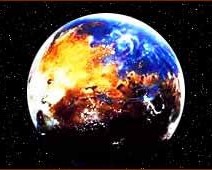 |
| What We Know About the Red Planet | ||||
| History | Water | Ice | Air | Canals |
| Seasons | Mountains | Rocks | SandDunes | Rift Valley |
| Moons | Dust Storms | Stats | Closest | Kid Pix |
| Lunar | Movies | Life Search | Wanted | Exploring Mars |
Poking up through the dust clouds:
The Mountains of Mars
What's the advantage of having a probe orbiting another planet? The orbiter can map the entire surface of the planet, repeatedly, to look for seasonal and long-term changes in features.
Mars Olympus Mons photographed by Viking 1
click to enlarge 260k NASA image
For instance, a global dust storm was sweeping the Red Planet as the first Mars orbiter from Earth, Mariner 9, arrived in 1971. The spacecraft had to wait three months to send back to Earth pictures of some important discoveries.
What were they? Poking through the top of the slowly settling cloud of dust were the tops of four immense volcanic mountains. The largest of these so-called "shield volcanoes" was named Olympus Mons (Mount Olympus).
Olympus Mons dwarfs the largest such feature on Earth, which is the largest of the Hawaiian Islands.
Shield volcanoes. On both Earth and Mars, shield volcanoes have been produced by out-pourings of fluid molten rock. Over a long time, that builds slowly into a huge mountain. There are no shield volcanoes on the Moon.
Olympus Mons is over 310 miles (500 kilometers) across at the base and stands 15 miles (24 kilometers) above a smooth plain. By contrast, the largest of the Hawaiian Islands is 75 miles (120 kilometers) across and 5.6 miles (9 kilometers) above the ocean floor.
Why the difference? The plate motion of Earth's surface produces a string of volcanoes along the ocean floor, while lack of plate motion on Mars piles up the volcanic material in one place, producing one immense volcano.
Four huge shield volcanoes have been seen on Mars, plus many smaller ones like those on the Earth. Most of Mars' major volcanic structures are in two regions where the crust has swelled upward. These crustal uplifts also are found on Earth, but not on the Moon.
Learn more: Human Exploration of Mars:
There have been three stages of exploration so farFlybys:
Probes fly by Mars taking pictures Orbiters:
Spacecraft fly into orbit above MarsLanders and Rovers:
- Orbiters
- Mariner 8-9
- Viking 1-2
- Mars Observer
- Mars Climate Orbiter
- Mars Global Surveyor
- Mars Global Surveyor home
- 2001 Mars Odyssey
- 2001 Mars Odyssey home
- Mars Express
- Mars Express home
- Mars Reconnaissance Orbiter 2005
- Mars Reconnaissance Orbiter home
Landers and rovers drop to the surfaceSand dunes: Dust Storms: Air: Carbon Dioxide: Outflow Channels: Valley Networks: Rift Valley: Ice: Ice caps: Frost: Water: Artesian Water: Mars Weather: Mars Photo Galleries: Planet features: Canals: Rocks: Mountains: Dating and aging: Seasons:

